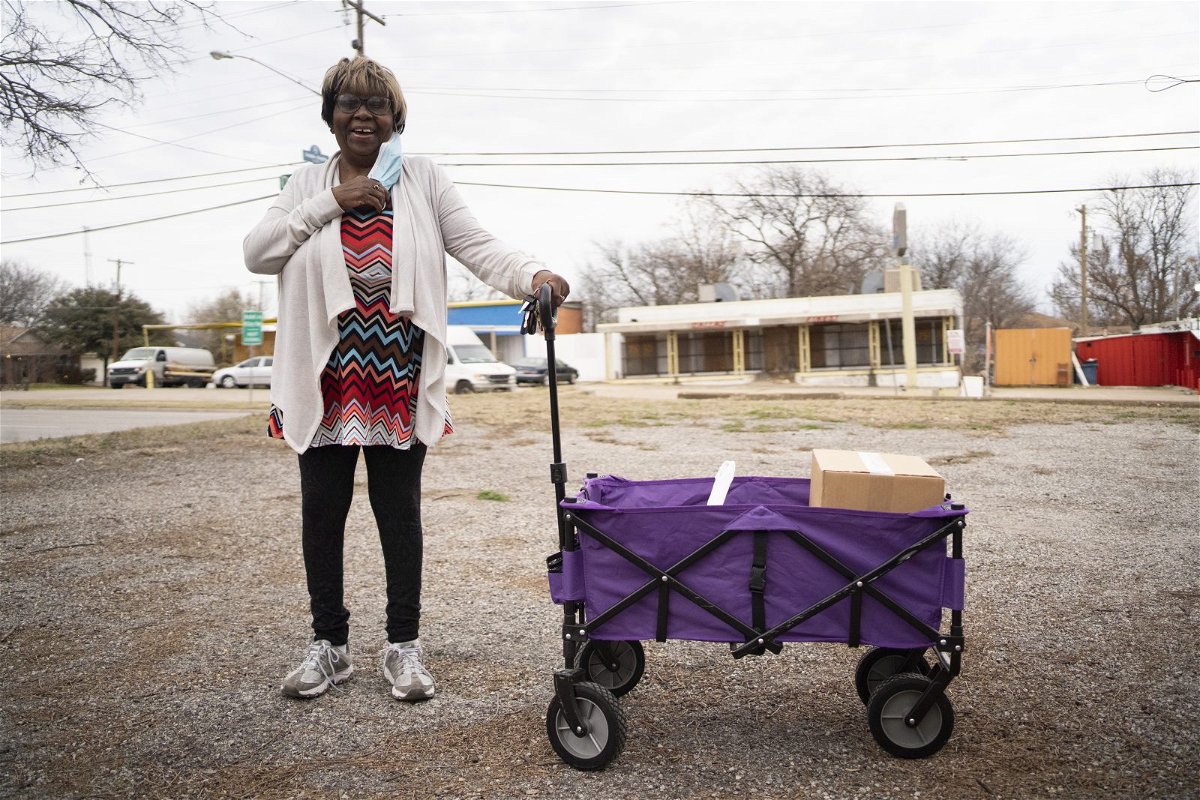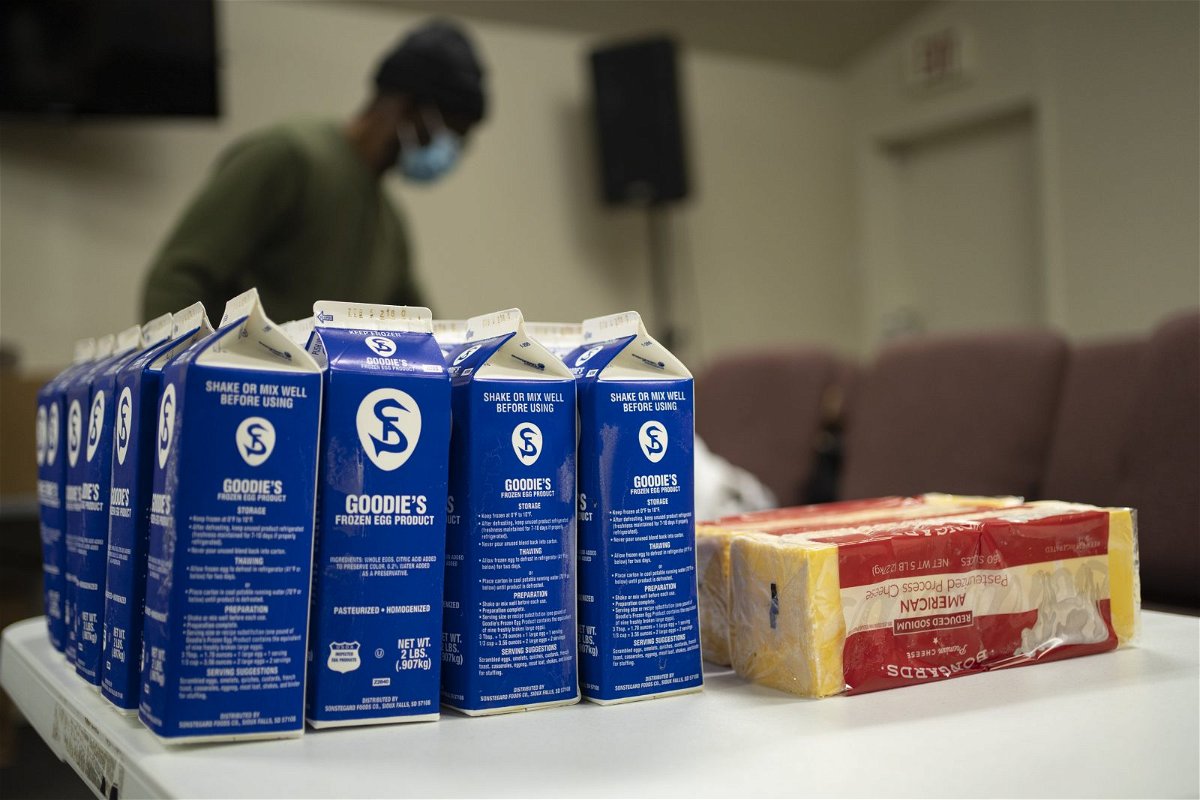
Mary Wesley walks to her church just a block from Carpenter’s Point, a housing community in Dolphin Heights for elderly people on a fixed income. She’s going to help pack boxes of food for her neighbors. She’s been volunteering once a month for 10 years.
“We enjoy giving out vegetables, because so many people like cooking vegetables, and meat sometimes, like tuna fish and sausage,” Wesley, 71, says.
This month, it’s mostly canned fruits and vegetables, spaghetti and ready-to-go meals. There are about 30 cartons of milk and prepackaged cheese. The fresh dairy items will go quickly.
As part of a North Texas-wide food distribution network, The Cities of Refuge church serves about 60 regular clients, says April Parker, the church’s executive assistant. Most are enrolled in government assistance programs, like the Supplemental Nutrition Assistance Program, known as SNAP. The nearest grocery store is more than a mile away.
Wesley and many others rely on The Cities of Refuge and nearby Progressive Baptist Church for access to healthy food.
“I think we definitely help to supplement to make sure people are getting nutritious food just because there isn’t a grocery store around here,” Parker says.
For the past 10 years, Crossroads Community Services, a North Texas Food Bank partner and food pantry in Red Bird, has built relationships with more than 100 community partners — churches like The Cities of Refuge, public housing facilities and community centers — to address food insecurity.
This is part of Crossroads’ community distribution partner model, a unique approach to food distribution that serves almost 32,000 people across Dallas and neighboring counties. Crossroads works with community partners to enroll clients in its food assistance program. Then, at least once a month, the partner picks up the food in bulk from Crossroads’ southern Dallas facility.

Parker says The Cities of Refuge spends $100 to $125 a month for a delivery van and driver, depending on the size of the load. Volunteers then organize the food and distribute it to neighborhood clients who are enrolled in the program and expected to pick up their food consistently on a monthly basis.
Parker orders the food online. “I try to get the proteins first, because they are the most filling, and go down from there,” she says. The spring and summer are better for fresh fruits and vegetables.
“Most people that come to our [Red Bird] food pantry come to it as a last resort, when their food stamps have run out at the end of the month,” says Katie Peters, who manages community relations at Crossroads. “The unique thing about our community partners is that they typically have recurring clients … Our community partners, by design, are truly within the community.”
Rooted in a neighborhood, a community partner like The Cities of Refuge already has strong relationships with residents. So the neighborhood food distribution site can be more accessible and approachable.
Some clients remain enrolled with their neighborhood community partner for several months until they no longer need food assistance. Others have continued to rely on the distribution for years.
Researchers from UT Southwestern Medical Center and the University of Dallas have been working with Crossroads since 2011 as part of the Community Assistance Research (CARE) initiative, which seeks solutions to systemic problems in the Dallas area.
Their latest study, set to be published later this year, shows that clients who use food assistance consistently suffer significantly less food insecurity and experience better health outcomes when compared to residents who use a central pantry, like the one at Crossroads in Red Bird, as a last resort.
According to Tammy Leonard, the co-director of CARE, the Crossroads community distribution model provides the framework to develop a long-term, community-based approach to food assistance that may be part of the solution to food insecurity.
Their research shows that clients of the Crossroads pantry typically travel an average of 7.8 miles to get food, while clients who receive food from community partners travel an average of 1.6 miles.
For the elderly community at Carpenter’s Point, access to transportation has been one of the main barriers in getting access to healthy food. Wesley is one of few residents who has her own car. She often gives rides to neighbors when they have to go to the store or pay their bills.

According to Leonard, low-income elderly people may be a population whose needs are met particularly well by this model, due to health challenges, difficulty with transportation and the need for social connectivity.
The residents surveyed for the study who received food from community partners also report significantly better overall health.
“They have better self-rated health, which is a very general, easy-to-answer question, but it’s fairly predictive of health outcomes like life expectancy,” Leonard says.
Parker knows that’s definitely the case for the clients who come to the Cities of Refuge Church. “With the population we serve, there are a lot of pre-existing conditions like diabetes, hypertension and cancer,” she says. Several of her clients aren’t on as much medication as they were before the distributions started.
“This approach that Crossroads has — reaching out to other organizations that really know their local community and enrolling them into these monthly food deliveries — is not the norm, but it’s been rather successful and is definitely replicable,” Leonard says.
The North Texas Food Bank says this model has been effective, and while the organization is not currently working to expand it, the Food Bank is supporting Crossroads to continue this work with smaller community partners.
“The community distribution partner model is really kind of relegated to two of our major agencies, Crossroads Community Services and Sharing Life out of Mesquite,” says Valerie Hawthorne, government relations director at the North Texas Food Bank.
“We are working on investing in partner growth … looking at where there is high need, what agencies already exist there and how we can further grow them to serve their community better,” she says.

Many smaller organizations in high-need communities do not have the staff or resources to operate a full-fledged pantry, Peters says. A food pantry, like Crossroads, traditionally opens several hours a week to serve a large number of clients who need emergency food assistance on a walk-in basis.
“Cities of Refuge doesn’t have the capacity to store food, but they still want to serve, and they still have a need in the area,” Peters says. “That’s why they’re a community distribution partner. We don’t require them to be open three hours a week. We don’t require them to store the food. But they can still serve a need.”
Even though the community partners may be a lot closer to clients, their limited hours can make them inaccessible in other ways.
Finding a day of the month that works best for their clients has been a challenge, says Parker of Cities of Refuge. The distributions used to be held on the first Thursday of the month, but many of the seniors seemed to miss them.
“We realized that’s when most people get their checks, so they are out paying their bills,” Parker says. “We moved it to the second Thursday and that seems to have helped a lot.”
Parker says that before the pandemic, the church staff discussed taking on another monthly distribution day, but they are hesitant to ask for more commitments from volunteers. Most of them, like Wesley, are elderly clients themselves.
“They’re very dependable,” Parker says. “They really like to be involved, and our volunteer program works really well.” But she’s not sure they have the manpower to take on more frequent distributions.
Plus, Parker says, some clients receive Meals on Wheels daily and weekly food distributions from the Progressive Baptist Church down the street.
Betty Olomola, another Carpenter’s Point resident, says right after the recent winter storms, she didn’t know anyone who was struggling with not having enough food.
“When we have extra, we give it to people in the building,” she says, referring to her Carpenter’s Point neighbors. “We put it on the mailroom table so anyone can come and get it.”
She’s grateful for the shared community and the work of the churches. But it’s still not like having a grocery store in your neighborhood.
“It helps a lot, especially for those of us who have trouble getting around,” Olomola says. “But, it’s very hard to find what you are going to need, even though these places do the best that they can.”

Parker agrees with Olomola. She says the church is helping, but the approach doesn’t replace having a nearby grocery store.
“We do what we can,” she says, “but we definitely don’t take the place of a Kroger or Tom Thumb … It shouldn’t be that big a deal just to get your staples — your milk, your eggs — that you need every day.
“I feel like this area is overlooked as far as having those local grocery stores that people can go and get the things that they need. I think it is very unfortunate. It’s an injustice.”
This story is part of a project on potential solutions to food insecurity in the neighborhoods of South Dallas and West Dallas. It’s reported through a partnership of the nonprofit Dallas Free Press and The Dallas Morning News, with support from the Solutions Journalism Network. For more information, email info@dallasfreepress.com.

Leave a Reply